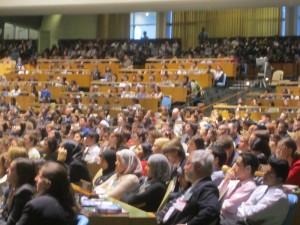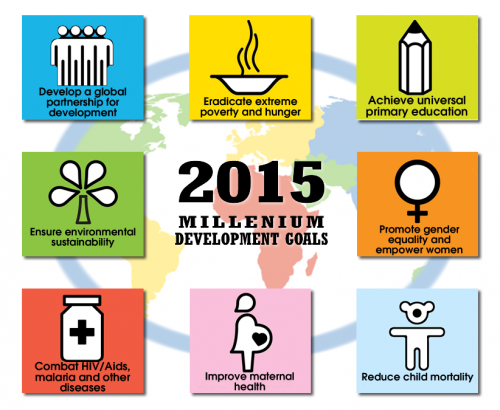
What does Model UN teach students about the actual UN?
KFC spoke on a panel at McGill SSUNS last week and several Canadian advisors asked him about how to teach the UN’s successes. They always hear about the UN’s failures in the media and they wanted to provide their students with a different perspective.
I actually went through the experience of teaching the UN’s successes and failures several weeks ago with my own students in Orange County. In honor of UN Day, I asked them:
“What has Model UN taught you about the actual UN? In your opinion, what have been the UN’s greatest successes and failures? Do you think the UN matters?”
We had a Socratic discussion, taking turns presenting our opinions and questioning one another. Most of my students believed that the UN is good in principle but bad in practice; they appreciated the UN’s idealism but did not think it made a difference. I then examined their assumptions about the UN, challenging their criticisms with examples of UN achievements, and also questioning whether the UN is as idealistic as they think; I pointed out that the UN is designed to serve the interests of its member states.
I realize now that my students’ beliefs about the UN reflect what the Canadian advisors pointed out to KFC. Drawing from my recent teaching experiences, I’d like to share 3 resources that I believe teachers would find helpful for teaching students about the successes and failures of the United Nations.

The UN has a long list of successes, including providing humanitarian aid to disaster-stricken areas
Past Successes: 60 Ways the UN Makes a Difference
My students’ main criticism of the UN was that the organization has not made a significant impact on worldwide problems. I challenged this claim by suggesting that their perspective is shaped by living in the United States, where we don’t see the results of UN programs. I then brought up this list of “60 Ways the UN Makes a Difference,” which the UN put together in celebration of its 60th anniversary six years ago.
This website is a great resource for showing your students what the UN has actually accomplished. The list is long, so I would encourage teachers to focus on a few big accomplishments. Here are 2 that I used in class:
- A concrete example of the UN’s achievements is its impact on world health. The World Health Organization has played a key role in treating infectious diseases around the world since 1948. If you’ve ever been worried by outbreaks of swine flu, bid flu, or SARS in the past decade, then you should know that the WHO was responsible for coordinating international efforts to combat those epidemics. The WHO is also leading international efforts against HIV/AIDS and malaria, but its biggest win has been smallpox. This disease used to kill millions of people a year, but worldwide vaccination efforts coordinated by the WHO led to the complete eradication of smallpox in 1979.
- One of the UN’s biggest successes goes largely unnoticed: decolonization. Before World War II, millions of people lived in colonies that were dependent on foreign powers. After the war, those foreign powers started dismantling their empires and looked to the UN for help. The UN’s founders believed that decolonization would be their biggest challenge, and there was considerable controversy over including the chapters on “non-self-governing territories” in the UN Charter. Instead, the UN became instrumental in helping millions of people achieve independence, and decolonization turned out to be one of their biggest successes. In fact, the Trusteeship Council, which was the UN body responsible for decolonizing a handful of former colonies, no longer meets because all of its trustees became independent countries.
Suggested Activity: Have your students pick one of the UN’s achievements and present it to the rest of the class. They should research the achievement they choose and create a presentation that addresses the question, “Why does this matter?” They can cite how many countries and people it impacts, how many lives have been saved, etc. (Thanks to KFC for suggesting this activity!)

The movie "Hotel Rwanda" explores the 1994 Rwandan Genocide, which the UN and the international community has admitted as one of their biggest failures
Recent Failures: The Rwandan Genocide
In addition to challenging my students’ criticisms of the UN, I also wanted to question their assumption that the UN is completely idealistic. I contrasted the UN Charter’s lofty preamble and purposes – examples of idealism – with the principle of sovereignty and the power given to the Permanent 5 countries – examples of pragmatism. I suggested that the UN is designed to serve the interests of its member states, and if those interests conflict with UN ideals, then the UN cannot act. To make this point, I brought up the example of the Rwandan Genocide.
In 1994, the Rwandan government organized the mass murder of an estimated 800,000 people. There was a UN peacekeeping mission in Rwanda during the genocide, but UN officials believed that their Security Council mandate did not give them the right to intervene. The international community actually withdrew peacekeepers, reducing the size of the mission from 2,165 people – already deemed not large enough to prevent a large-scale outbreak of violence – to 270. A French-led force was sent in later to stop the genocide, but not until thousands of Rwandans had already been killed. In the decade and a half since these events took place, the UN and the international community have admitted the Rwandan Genocide as one of their greatest failures.
Teachers can use this UN website to learn more about the Rwandan Genocide and the international community’s failure to act. The site contains a history of events, official UN reports and statements, and educational resources for teaching students about what happened and why, lessons learned, and how to prevent future genocides.
Suggested Activity: Watch the critically-acclaimed movie “Hotel Rwanda” with your students and lead them in a discussion. Based on a true story, Don Cheadle gives an Oscar-nominated performance as hotel manager Paul Rusesabagina, who turns his hotel into a refugee camp in order to save fellow Rwandans from the genocide. The movie also depicts the inaction of the UN and the international community, and explores themes of political corruption and violence. The movie is rated PG-13 and I think it’s appropriate to show to older students, but be aware of its serious subject matter and several heart-wrenching scenes; you can read a parent review of the movie here.

Studying the Millennium Development Goals is an opportunity for students to evaluate the UN's successes and failures
Future Challenges: Millennium Development Goals (MDGs)
To conclude the discussion with my students, I wanted them to consider whether the UN will continue, in their opinion, to succeed or fail. I presented them with one of the biggest challenges facing the UN today: achieving the Millennium Development Goals.
In 2000, world leaders gathered at the UN to set global policy on fighting poverty and promoting development. They set a vision for a better world by signing the Millennium Declaration, turned this vision into measurable targets by creating the Millennium Development Goals, and gave themselves a deadline for reaching these goals by 2015. The goals are:
- Goal 1: Eradicate extreme poverty and hunger
- Goal 2: Achieve universal primary education
- Goal 3: Promote gender equality and empower women
- Goal 4: Reduce child mortality
- Goal 5: Improve maternal health
- Goal 6: Combat HIV/AIDS, malaria and other diseases
- Goal 7: Ensure environmental sustainability
- Goal 8: Develop a Global Partnership for Development
There are several UN websites on the MDGs, but I think the best resource is the UN’s annual report. The report’s overview describes where the international community is on track to reach these goals and where it is lagging behind.
Suggested Activity: Ask your students to start a non-governmental organization (NGO) that addresses one of the MDGs. You can make it a group project where students form teams, identify which goal they want to work on, and pick a country that they want to help. They’ll have to research the goal, the country, and possible solutions, and then create a poster to present their NGO to the class. (Thanks to UCI Global Connect for showing me this activity!)
This article is part of my series on “How to Teach Model UN.” How do you teach your students about the UN’s successes and failures? Leave a comment below!

